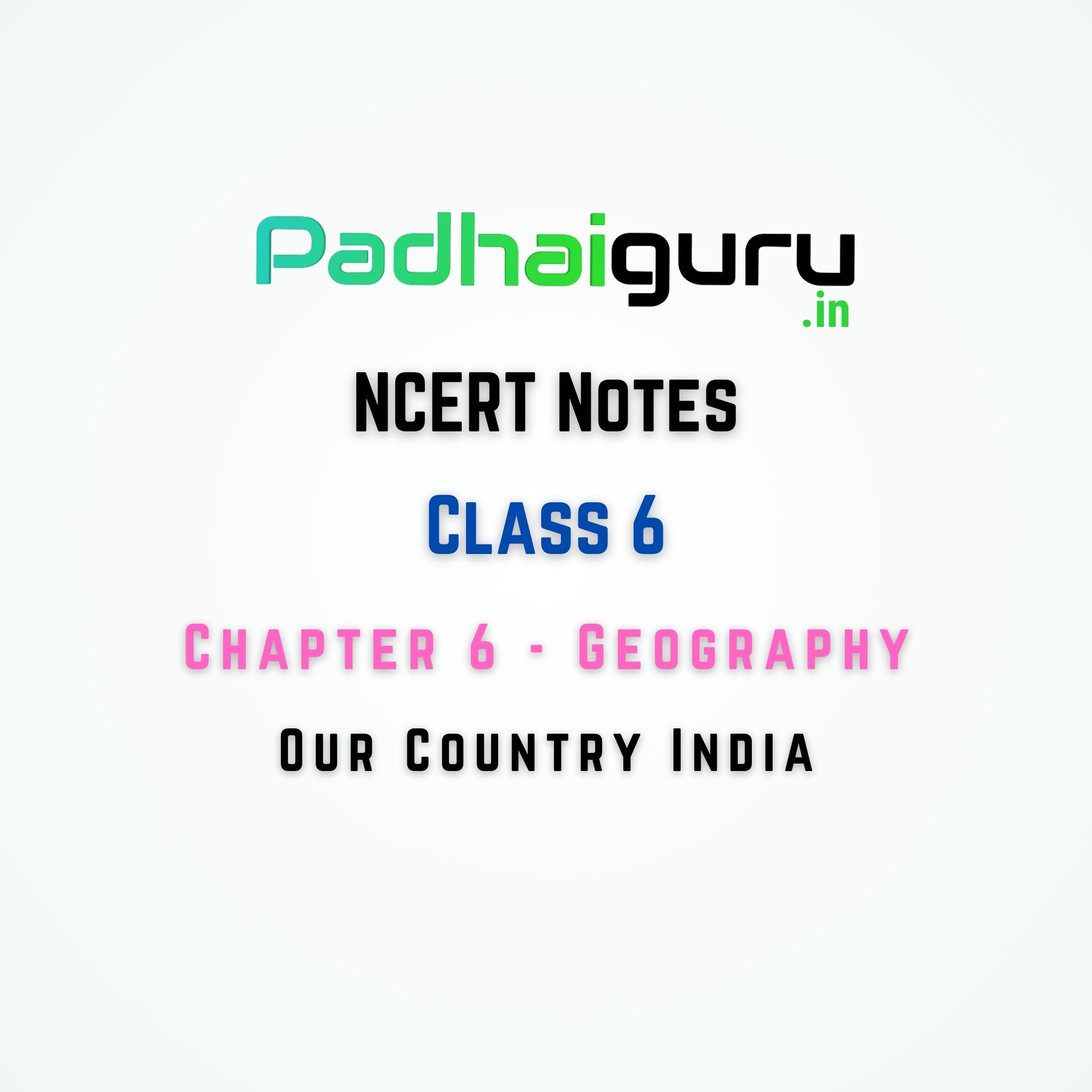06. Our Country India class 6 Chapter 6 Geography – NCERT Notes for CBSE

Welcome to Our Country India class 6 Chapter 6 Geography – NCERT Notes for CBSE .
Our Country – India
Geography Class 6 – Chapter 6
India, a country of vast geographical expanse, is characterized by its diverse and unique features.
Geography and Geographical Extent
- Location: India is located in the northern hemisphere, and it spans between the latitudes 8°4’N to 37°6’N and longitudes 68°7’E to 97°25’E.
- Boundaries: India shares land boundaries with seven countries and is surrounded by the Arabian Sea in the west, the Bay of Bengal in the east, and the Indian Ocean in the south.
- Area: India covers approximately 3.28 million square kilometers.
- North-South Extent: It stretches about 3,200 kilometers from Ladakh in the north to Kanyakumari in the south.
- East-West Extent: The east-west extent ranges from Arunachal Pradesh in the east to Kuchchh in the west.
Physical Divisions of India
India’s diverse landscape includes various physical divisions:
The Himalayas
- The Himalayan mountain range in the north is divided into three main parallel ranges.
- The northernmost range is the Great Himalaya or Himadri, housing the world’s highest peaks.
- South of Himadri lies the Middle Himalaya or Himachal, where many popular hill stations are situated.
- The southernmost range is the Shiwalik.
The Northern Plains
- South of the Himalayas are the Northern Plains, known for their level and flat terrain.
- These plains are formed by the alluvial deposits of rivers like the Indus, Ganga, Brahmaputra, and their tributaries.
- The fertile land here supports high population density.
The Great Indian Desert
- In the western part of India lies the Great Indian Desert, a dry, hot, and sandy region with minimal vegetation.
The Peninsular Plateau
- To the south of the Northern Plains is the Peninsular Plateau, a triangular region with diverse topography, including hill ranges, valleys, and plateaus.
- Aravali hills, one of the oldest mountain ranges globally, border it on the northwest side.
- Rivers like Narmada and Tapi flow through this region, eventually draining into the Arabian Sea.
Coastal Plains
- Coastal plains are found both to the west and east of the Peninsular Plateau.
- The western coastal plains are narrow, while the eastern coastal plains are broader.
- These regions are influenced by rivers like Mahanadi, Godavari, Krishna, and Kaveri, which have formed fertile deltas at their mouths.
- The Sunderban delta, where the Ganga and Brahmaputra flow into the Bay of Bengal, is a significant feature.
Islands
- India has two groups of islands: the Andaman and Nicobar Islands in the Bay of Bengal and the Lakshadweep Islands in the Arabian Sea.
- The Andaman and Nicobar Islands are situated to the southeast of the Indian mainland.
- Lakshadweep Islands are coral islands off the coast of Kerala.
India’s Administrative Divisions
- India is administratively divided into 28 States and 8 Union Territories.
- Delhi serves as the national capital.
- States are primarily formed based on languages, ensuring cultural diversity is respected.
Definitions:
- Himalayas: A mountain range in northern India, known for its three parallel ranges and the world’s highest peaks.
- Northern Plains: Flat and fertile plains south of the Himalayas formed by alluvial deposits from major rivers.
- Great Indian Desert: A dry and sandy region in western India with minimal vegetation.
- Peninsular Plateau: A triangular region in southern India with diverse topography, including hill ranges and plateaus.
- Coastal Plains: Low-lying areas along India’s coast influenced by major rivers and forming fertile deltas.
- Islands: Landmasses surrounded by water, including the Andaman and Nicobar Islands and Lakshadweep Islands.
- Administrative Divisions: The political subdivisions of India, including States and Union Territories.
Frequently Asked Questions (FAQs)
1. What is India’s geographical location?
- India is located in the northern hemisphere, between latitudes 8°4’N to 37°6’N and longitudes 68°7’E to 97°25’E.
2. What are the major physical divisions of India?
- India has several physical divisions, including the Himalayas, Northern Plains, Great Indian Desert, Peninsular Plateau, and Coastal Plains.
3. Which is the oldest mountain range in India?
- The Aravali hills in India are one of the oldest mountain ranges in the world.
4. What are the two groups of islands belonging to India?
- India has two groups of islands: the Andaman and Nicobar Islands and the Lakshadweep Islands.
5. How is India’s cultural diversity reflected in its administrative divisions?
- India’s States are primarily formed based on languages, ensuring that the country’s cultural diversity is respected.
6. Why is the Northern Plains of India densely populated?
- The Northern Plains are densely populated due to their fertile alluvial soil, which is ideal for agriculture.
7. What is the significance of the Sunderban delta?
- The Sunderban delta is where the Ganga and Brahmaputra rivers flow into the Bay of Bengal, forming the world’s largest delta.
8. What makes the Great Indian Desert unique in India’s landscape?
- The Great Indian Desert is a dry and hot region in western India with minimal vegetation.
9. How is India’s location related to time zones?
- Due to its vast longitudinal extent, India experiences a time difference of about two hours between its eastern and western extremities.
10. What are the main features of the Himalayan mountain range in India?
- The Himalayas consist of three parallel ranges: the Great Himalaya (Himadri), Middle Himalaya (Himachal), and Shiwalik. The world’s highest peaks are located in the Himadri range.
This overview provides insights into India’s diverse geography and administrative divisions, reflecting the unity in its cultural diversity.
This was the end of Our Country India class 6 Chapter 6 Geography – NCERT Notes for CBSE.
For more information, refer to NCERT SOLUTIONS, NCERT NOTES, and NCERT BOOKS .
